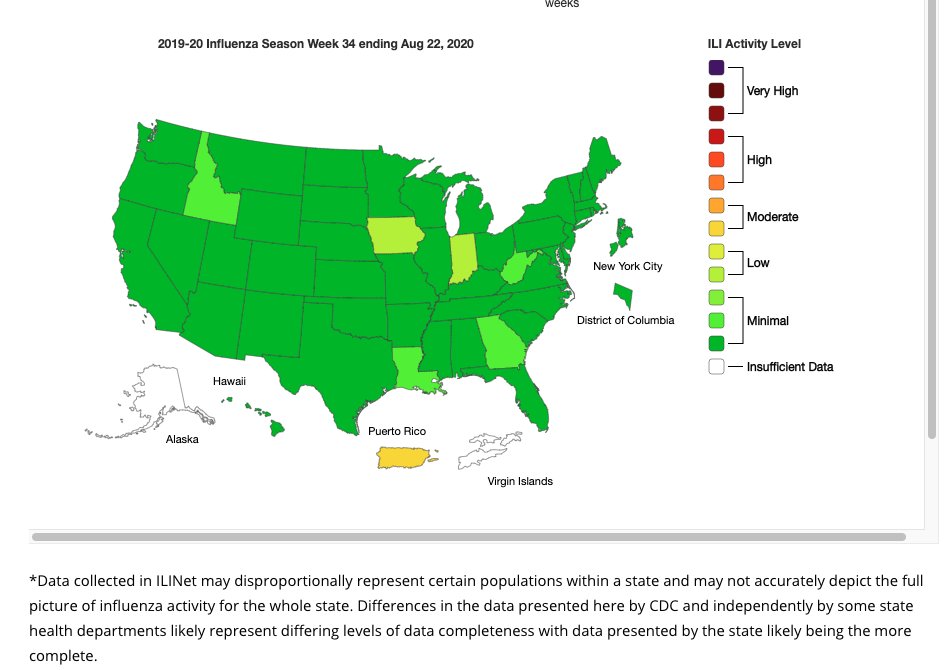1/ We have heard about a number of potential breakthroughs for COVID response- large scale/cheap testing, immune therapy, vaccine progress.
But when it comes to "getting eyes on the outbreak" we are still peering through the same dirty windshields.
Could $100k change that? https://twitter.com/DukeMargolis/status/1300815891177897984">https://twitter.com/DukeMargo...
But when it comes to "getting eyes on the outbreak" we are still peering through the same dirty windshields.
Could $100k change that? https://twitter.com/DukeMargolis/status/1300815891177897984">https://twitter.com/DukeMargo...
2/ We *still* don& #39;t have a good answer to the most fundamental epidemiologic question - "what& #39;s the intensity of COVID activity in my community this week?"
We have lots of websites and lots of citizen scientists (including me) trying to piece it together https://www.nytimes.com/2020/07/21/opinion/coronavirus-state-data.html">https://www.nytimes.com/2020/07/2...
We have lots of websites and lots of citizen scientists (including me) trying to piece it together https://www.nytimes.com/2020/07/21/opinion/coronavirus-state-data.html">https://www.nytimes.com/2020/07/2...
3/ This *matters*
We don& #39;t have a national strategy.
The CDC has been muzzled.
State/local leaders are mostly overwhelmed with trying to figure out what& #39;s going on, or have stopped looking at science altogether.
Businesses, schools, families have to decide for ourselves...
We don& #39;t have a national strategy.
The CDC has been muzzled.
State/local leaders are mostly overwhelmed with trying to figure out what& #39;s going on, or have stopped looking at science altogether.
Businesses, schools, families have to decide for ourselves...
4/ And regardless of your risk tolerance, a key input into any decision-
"do I send my kids to school?"
"do I go into the store/ restaurant"
"do we invite people over"
is "What are the chances that someone I bump into is infectious with COVID?"
Tell me where I can find that
"do I send my kids to school?"
"do I go into the store/ restaurant"
"do we invite people over"
is "What are the chances that someone I bump into is infectious with COVID?"
Tell me where I can find that
5/ I& #39;m an infectious disease epidemiologist, trained at the CDC& #39;s epidemic intelligence service. spent a decade developing new public health surveillance methods.
I CAN& #39;T FIGURE IT OUT
The data we have is not good enough. Fancy methods can try to solve that, but not enough
I CAN& #39;T FIGURE IT OUT
The data we have is not good enough. Fancy methods can try to solve that, but not enough
6/ The fundamental reason is we never established "smart testing" in the US, what @ZekeEmanuel and I pleaded for in mid-March
There is no design. No systematic testing of the same population, with collection of key risk data, across jurisdictions
WTF https://twitter.com/Farzad_MD/status/1240587398586777601?s=20">https://twitter.com/Farzad_MD...
There is no design. No systematic testing of the same population, with collection of key risk data, across jurisdictions
WTF https://twitter.com/Farzad_MD/status/1240587398586777601?s=20">https://twitter.com/Farzad_MD...
7/ Fundamentally every one of those websites you look at are looking at diagnosed case counts. But we& #39;re only capturing 1 in 5-10 infections
We are testing different populations over time. Symptomatic? Hospitalized? Young? Workers? How do we know what& #39;s actually happening..soon?
We are testing different populations over time. Symptomatic? Hospitalized? Young? Workers? How do we know what& #39;s actually happening..soon?
8/ Some experts say that the only data they actually trust are COVID deaths (that& #39;s all IHME projections used).
@WeinbergerDan (and a group that included me) found that even those aren& #39;t reliable. In some areas massively undercounted
AND LATE, too late. https://jamanetwork.com/journals/jamainternalmedicine/fullarticle/2767980">https://jamanetwork.com/journals/...
@WeinbergerDan (and a group that included me) found that even those aren& #39;t reliable. In some areas massively undercounted
AND LATE, too late. https://jamanetwork.com/journals/jamainternalmedicine/fullarticle/2767980">https://jamanetwork.com/journals/...
9/ I had hoped that we would be able to harness the techniques I had helped develop 20 years ago- tracking not diagnoses (which depend on testing) but actual symptoms and syndromes-"covid-like illness" (CLI) that lead to people getting care- eg ER visits https://www.cnbc.com/2020/04/04/syndromic-surveillance-useful-to-track-pandemics-like-covid-19.html">https://www.cnbc.com/2020/04/0...
10/ Sorry BRB-
Literally have to go to a meeting to look at OUR OWN HOMEGROWN ANALYSIS* to see where we can safely send our staff into doctors offices
*Infection Intensity~ [Deaths past 2 weeks] X [change in case count past 4 weeks] X [change in positivity rate]
{holds head}
Literally have to go to a meeting to look at OUR OWN HOMEGROWN ANALYSIS* to see where we can safely send our staff into doctors offices
*Infection Intensity~ [Deaths past 2 weeks] X [change in case count past 4 weeks] X [change in positivity rate]
{holds head}
11/ [Back]
Syndromic Surveillance on ED "CLI" visits has been very helpful!
It was an incredibly scary moment when I saw on March 7th a huge increase in "difficulty breathing" visits in NYC, at a time when there were only 2 confirmed COVID cases https://twitter.com/Farzad_MD/status/1236417498314149892?s=20">https://twitter.com/Farzad_MD...
Syndromic Surveillance on ED "CLI" visits has been very helpful!
It was an incredibly scary moment when I saw on March 7th a huge increase in "difficulty breathing" visits in NYC, at a time when there were only 2 confirmed COVID cases https://twitter.com/Farzad_MD/status/1236417498314149892?s=20">https://twitter.com/Farzad_MD...
12/ It was also a huge relief when I saw the trends begin to flatten and the tide begin to turn on March 28th- the first indication of hope during a time when hospitalizations, ICU stays and deaths were still soaring
Thankfully, NYC made this data public https://twitter.com/Farzad_MD/status/1243944416475308032?s=20">https://twitter.com/Farzad_MD...
Thankfully, NYC made this data public https://twitter.com/Farzad_MD/status/1243944416475308032?s=20">https://twitter.com/Farzad_MD...
13/ But even though we HAVE this data nationally, even though it was part of the (mostly ignored) White House reopening criteria, it has never been made available nationally  https://abs.twimg.com/emoji/v2/... draggable="false" alt="☹️" title="Stirnrunzelndes Gesicht" aria-label="Emoji: Stirnrunzelndes Gesicht">
https://abs.twimg.com/emoji/v2/... draggable="false" alt="☹️" title="Stirnrunzelndes Gesicht" aria-label="Emoji: Stirnrunzelndes Gesicht">
that& #39;s a scandal, even if the @CDCDirector doesn& #39;t seem to realize it https://twitter.com/Farzad_MD/status/1266505504236408834?s=20">https://twitter.com/Farzad_MD...
that& #39;s a scandal, even if the @CDCDirector doesn& #39;t seem to realize it https://twitter.com/Farzad_MD/status/1266505504236408834?s=20">https://twitter.com/Farzad_MD...
14/ We need to improve the availability and transparency of this Emergency Room "syndromic" data for the public (and we gave very specific practical recommendations in this report, that were largely ignored by the feds)
But this data has a real problem... https://twitter.com/Farzad_MD/status/1256633535303204864?s=20">https://twitter.com/Farzad_MD...
But this data has a real problem... https://twitter.com/Farzad_MD/status/1256633535303204864?s=20">https://twitter.com/Farzad_MD...

 Read on Twitter
Read on Twitter



